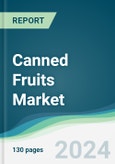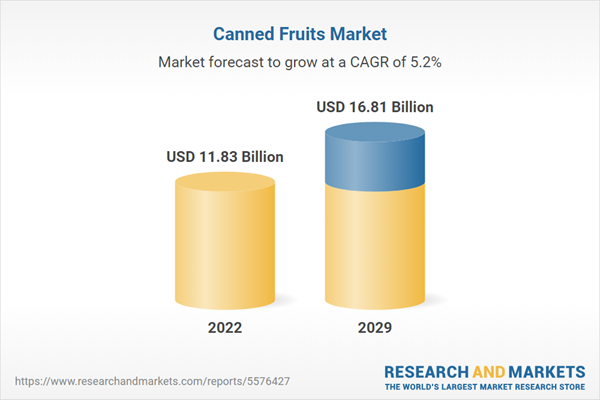Food canning is a technique for storing food at a standard temperature by preserving it in firmly closed vacuum-sealed containers after processing. Washing, sorting/grading, preparation, container filling, exhausting, container sealing, heat sterilization, chilling, labeling/casing, and shipping storage are all part of the canning process. Fruit canning has seen a transition in equipment utilization from batch units to continuous units, where cans are passed through an airlock and then rotated in a pressurized heat compartment before being chilled in a cold-water cooler compartment.
Market Drivers:
Rise in the importance of a balanced diet:
Canned foods play an important role in an overall balanced diet. Since canning retains many nutrients, it can be just as healthy and fresh as frozen foods. Individuals consuming more canned foods have a greater intake of fruits and vegetables as well as a higher intake of nutrients than individuals consuming fewer canned fruits and vegetables.Canned foods are a handy and cost-effective method to increase the intake of fruits and vegetables. The canning method provides a long shelf life of at least one to five years. This might be useful for people who frequently toss away fresh fruit due to spoilage.
Convenience as a growth factor:
Factors such as the extended shelf life of fruits due to better food preservation technologies, rapid urbanization rates, busy lifestyles, and rising demand for convenience meals, among others, are driving the market growth. The surge in nuclear families and the growing disposable income of households have resulted in a shift in consumer food consumption patterns, with convenient meals gaining popularity.Other factors boosting the market expansion include an increase in the number of working women throughout the world and the easier availability of a wide range of canned fruits. These fruits are available throughout the year and do not require the removal of stalks, peels, or pits, which adds to their convenience.
Market Restraint:
Needed demand from the fresh fruit market:
The persistent increase in demand for fresh and minimally processed foods is expected to have a detrimental influence on the canned food sector. Furthermore, the market is gradually shrinking due to an increase in outside food consumption and a decrease in home cooking practices.Canned fruits market segmentation by distribution channel into grocery stores, supermarkets, and online.
The segmentation of the canned fruits market by distribution channel includes grocery stores, supermarkets, and online retailers. Grocery stores and supermarkets frequently offer promotions and discounts on canned fruits, catering to a diverse customer base with varying price points and preferences.Online retailers have the advantage of catering to specific demographics and preferences, with an increasing variety of canned fruit brands and options available online.
APAC is anticipated to hold a significant share of the canned fruit market:
The Asia Pacific canned fruits market is expanding rapidly. The demand for processed meals is increasing as society continues to transform in this region. The fast-paced lifestyle and ever-increasing population are some of the major drivers of the growing demand for ready-to-eat food. Furthermore, with the growing demand for processed meals, there is a need to find healthier alternatives with a longer shelf life.Due to their ease of handling and ready-to-use capability, canned fruits prove to be the ideal solution for different purposes. With the development of China's food sector, the demand for canned fruits for a variety of uses is increasing exponentially.
Market Developments:
- November 2022- Del Monte®, the UK's canned fruit brand, announced its partnership with cookery author and television personality, Lisa Faulkner, to promote the positive benefits of consuming canned fruit and to underscore the value of integrating Del Monte®'s nutritious canned products into daily meals.
Market Segmentation:
By Product Type
- Canned peaches
- Canned cherries
- Canned pineapples
- Canned Mandarin Oranges
- Others
By Distribution Channel
- Grocery Stores
- Supermarkets
- Online
By Geography
- North America
- USA
- Canada
- Mexico
- South America
- Brazil
- Argentina
- Others
- Europe
- Germany
- France
- UK
- Italy
- Others
- Middle East and Africa
- Saudi Arabia
- UAE
- Others
- Asia Pacific
- China
- Japan
- India
- Indonesia
- Taiwan
- Thailand
- Others
Table of Contents
Companies Mentioned
- CHB Group
- Del Monte Food Inc.
- Princes Limited
- Rhodes Food Group
- Tropical Food Industries Co., Ltd.
- Delicia Foods India Pvt. Ltd.
- Langeberg & Ashton Foods
- Dole Packaged Foods LLC
- Vidya Sagar Food Pvt Ltd.
- Jutai Foods Group Ltd.
Table Information
| Report Attribute | Details |
|---|---|
| No. of Pages | 130 |
| Published | March 2024 |
| Forecast Period | 2022 - 2029 |
| Estimated Market Value ( USD | $ 11.83 Billion |
| Forecasted Market Value ( USD | $ 16.81 Billion |
| Compound Annual Growth Rate | 5.1% |
| Regions Covered | Global |
| No. of Companies Mentioned | 10 |









